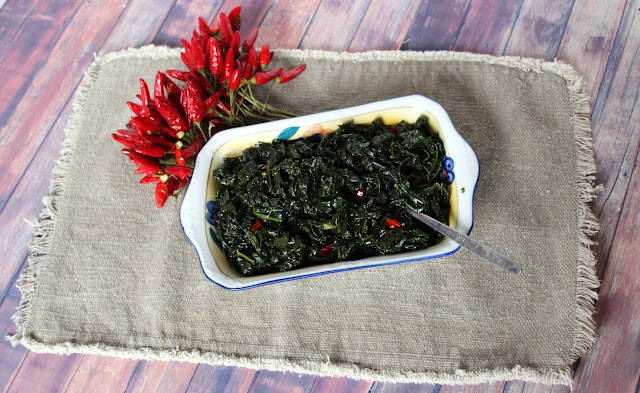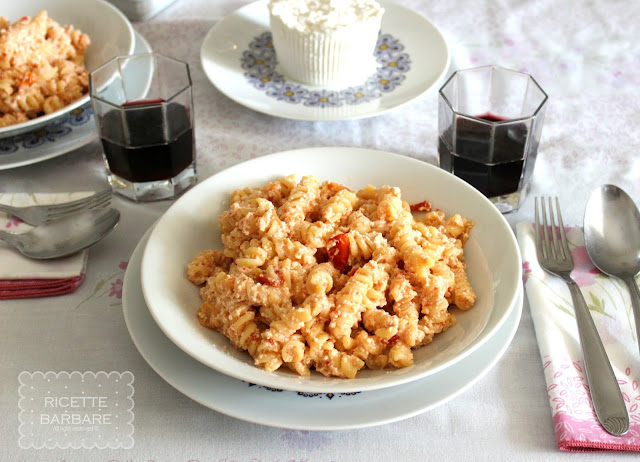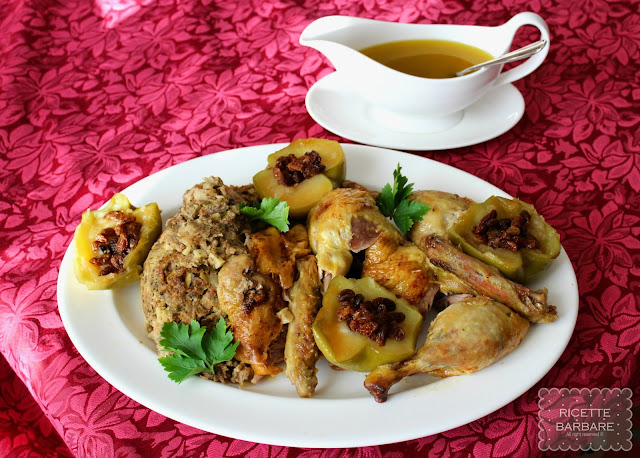Era il 1987 e la Chef Laila Adamolli Ban nella sua scuola La Cucina ci insegnava a preparare due splendidi menù per le feste, uno a base di pesce ed uno di carne con questa gustosissima anatra ripiena alle mele verdi (ma potreste scegliere una faraona e avreste un'ottima alternativa). Da quel momento questo piatto è entrato a pieno titolo nelle tradizioni della mia famiglia e ora voglio condividerlo con voi!
English version below
Sapore: Ottimo connubio, il ripieno è... celestiale!!!
Complessità: Media difficoltà, visto che dovete anche saper tenere in mano ago e filo!
Dove l’ho trovato? Ricetta della Chef Laila Adamolli Ban
Per realizzare un'ottima anatra ripiena alle mele verdi vi
occorreranno:
1 anatra (oppure una faraona o un fagiano) del peso di circa 1,800 g
5 mele granny smith
150 g di polpa di maiale macinata
100 g di salsiccia
1 cipolla, 1 carota, 1 costa di sedano tritati grossolanamente
1 panciata di mollica di pane raffermo o di pangrattato, messo a bagno
nel marsala secco e strizzato
1 uovo
1 spicchio di aglio
1 cucchiaio raso di maizena
circa 3 mestoli di brodo
burro
olio extravergine d'oliva
1/2 bicchiere di brandy
aglio, rosmarino, timo
sale, pepe, noce moscata
uva sottospirito
30 g di parmigiano grattugiato
1 cucchiaio di prezzemolo tritato
2 cucchiaio di zucchero semolato
timo e rosmarino freschi
vino bianco secco
La preparazione è un po' lunga, ma niente di troppo
complicato. Cominciate con lo sbucciare una mela, privarla del torsolo e
tagliarla a cubetti o tritarla con il robot da cucina, ma senza ridurla in
crema.
Mescolate accuratamente la polpa di maiale, la
polpa della salsiccia privata del budello, il pane grattugiato ammollato nel
marsala e ben strozzato. Unite poi i cubetti di mela, l'uovo leggermente
battuto, il parmigiano grattugiato ed il prezzemolo tritato.
Salate, pepate, unite una grattatina di noce moscata e mescolate
accuratamente.

Prendete l'anatra che avrete lavato precedentemente sotto l'acqua corrente e ben asciugato, salate l'interno e riempitela con il composto preparato in precedenza.
Con ago e filo bianco cucite quindi sia l'apertura sotto la coda che il collo dell'anatra. Salatela esternamente e mettetela in una teglia con olio e burro. Contornate con il trito grossolano di cipolla, carota e costa di sedano, lo spicchio di aglio vestito e schiacciato, un rametto di timo ed uno di rosmarino. Passate in forno già caldo a 190°C per due ore abbondanti, avendo cura di irrorare due o tre volte con 3 tazze di vino bianco.
Mentre l'anatra cuoce in forno occupiamoci delle mele. Lavare le restanti quattro mele e senza sbucciarle tagliatele a metà e privatele del torsolo.
Sciogliere del burro in un tegame che possa contenere le 8 mezze mele e adagiatevi i frutti con la parte tagliata verso il basso. Soffriggetele per una decina di minuti coperte, a fuoco bassissimo- Cospargete poi le mele con lo zucchero semolato, irrorate con 1/2 bicchiere di brandy e successivamente con poco vino bianco. Continuate a cuocere per una decina di minuti, fino a quando il vino non si è asciugato, smuovendo il recipiente di tanto in tanto.
Quando l'anatra avrà portato a termine la sua cottura, toglietela dal forno e posatela sul piatto di portata, sgrassando il fondo di cottura. Aggiungetevi quindi un bicchiere di brodo freddo, nel quale avrete sciolto un cucchiaio raso di maizena, mescolate e fate sobbollire per qualche minuto.
Filtrate poi con un colino fine e nappate l'anatra con la salsa, serbandone un po' per servirla in accompagnamento. Contornare con le mezze mele mettendo al centro di ognuna l'uvetta sottospirito e... portate in tavola!
Stuffed Duck with Green Apples
Ingredients
1 duck (or guinea fowl or pheasant) weighing about 1.800 kg weighing about 4.000 oz
5 granny smith apples
150 g (5.3 oz) ground pork
100 g (3.5 oz) sausage
1 onion, 1 carrot, 1 celery stalk, chopped coarsely
1 handful of stale bread crumbs or breadcrumbs soaked in dry Marsala and squeezed dry
1 egg
1 clove of garlic
1 level tablespoon of cornstarch
About 3 ladles of broth
Butter
Extra virgin olive oil
1/2 cup brandy
Garlic, rosemary, thyme
Salt, pepper, nutmeg
Raisins in spirits
30 g grated Parmesan cheese
1 tablespoon chopped parsley
2 tablespoons granulated sugar
Fresh thyme and rosemary
Dry white wine
Instructions
The preparation is a bit long, but nothing too complicated. Start by peeling one apple, removing the core and cutting it into cubes or chopping it with a food processor, but without reducing it to a cream.
Mix together the ground pork, the sausage meat without the casing, the bread crumbs soaked in Marsala and well squeezed. Add the apple cubes, the lightly beaten egg, the grated Parmesan cheese and the chopped parsley.
Season with salt, pepper, add a pinch of nutmeg and mix thoroughly.
Take the duck that you have previously washed under running water and dried well, season the inside and fill it with the mixture prepared previously.
With a needle and white thread, sew up both the opening under the tail and the neck of the duck. Season it externally and place it in a baking dish with oil and butter. Surround with the coarsely chopped onion, carrot and celery stalk, the dressed and crushed garlic clove, a sprig of thyme and one of rosemary. Bake in a preheated oven at 190°C (374°F) for two hours, making sure to baste two or three times with 3 cups of dry white wine.
While the duck is cooking in the oven, let's take care of the apples. Wash the remaining four apples and cut them in half without peeling them, then remove the core.
Melt some butter in a pan that can hold the 8 halves of apples and place the fruit with the cut side down. Sauté for about 10 minutes covered, over low heat. Sprinkle the apples with granulated sugar, drizzle with 1/2 cup of brandy and then with a little dry white wine. Continue cooking for about 10 minutes, until the wine has dried up, stirring the container occasionally.
When the duck has finished cooking, remove it from the oven and place it on the serving dish, degreasing the bottom of the cooking dish. Add a glass of cold broth, in which you have dissolved a level tablespoon of cornstarch, stir and simmer for a few minutes.
Then strain with a fine sieve and coat the duck with the sauce, reserving some to serve on the side. Garnish with the halves of apples, placing the raisins in spirits in the center of each one and... serve!






